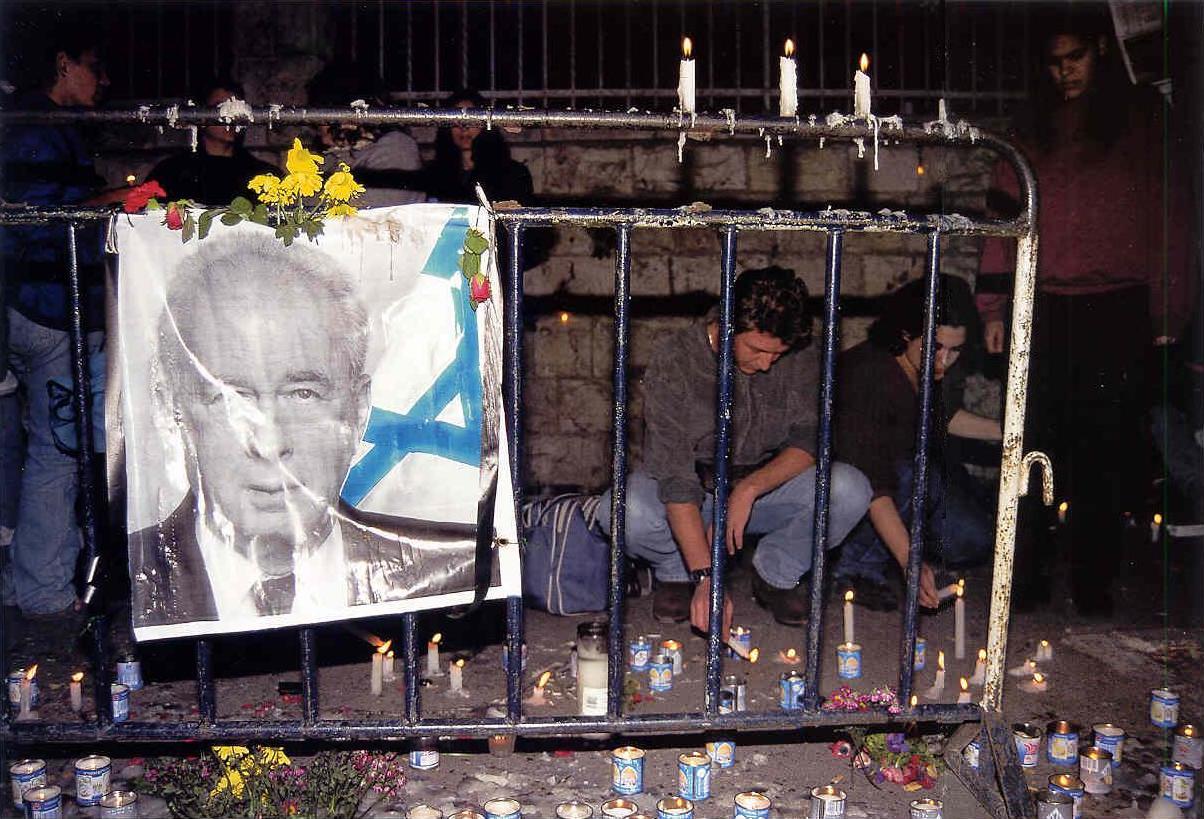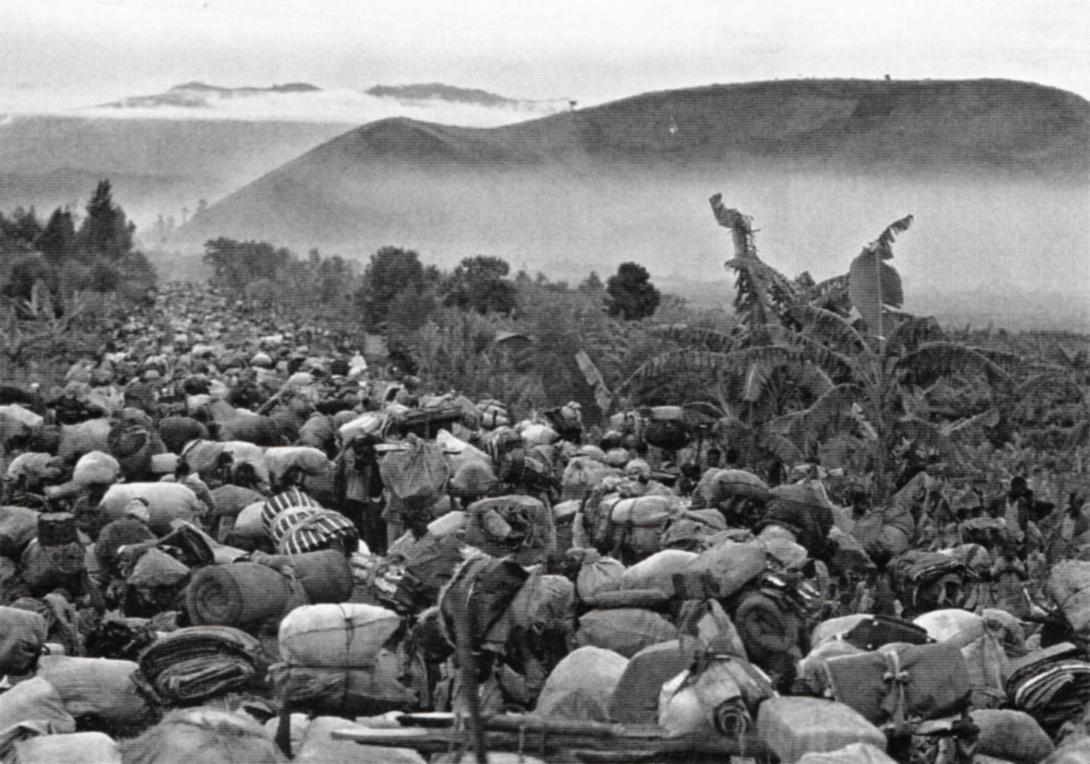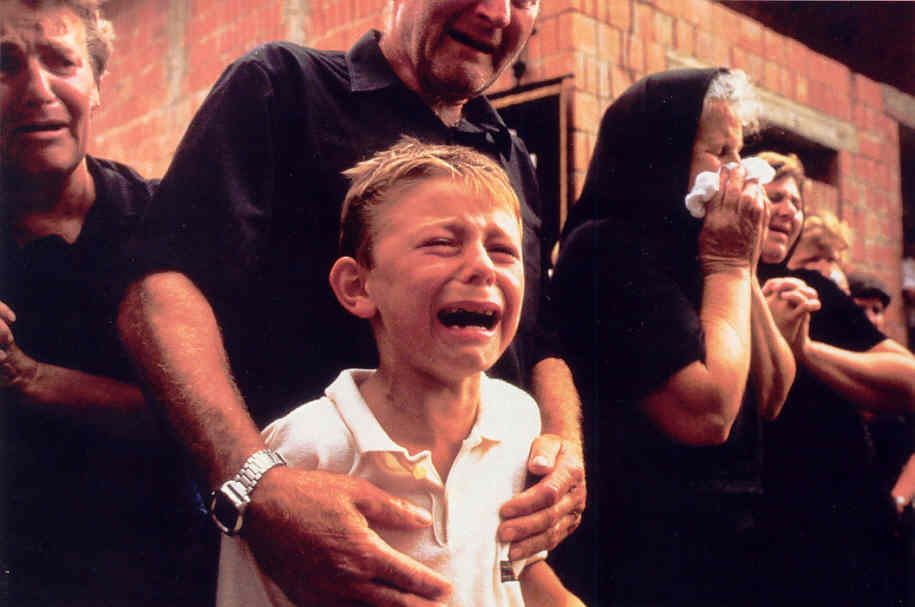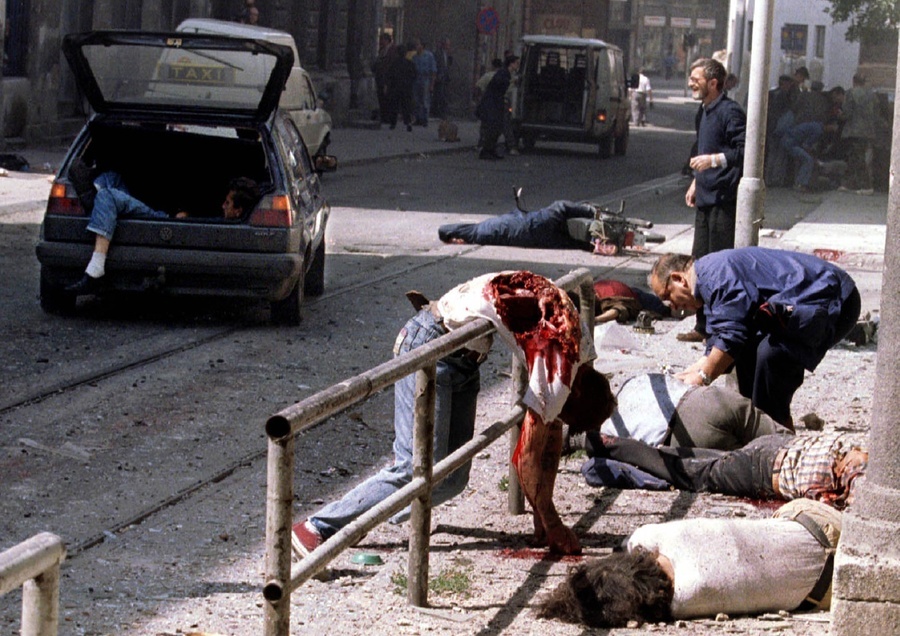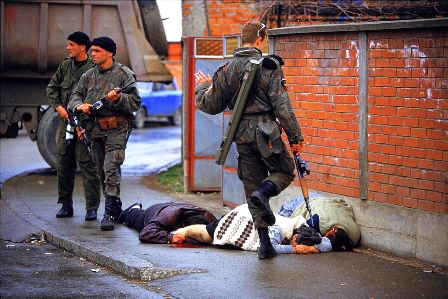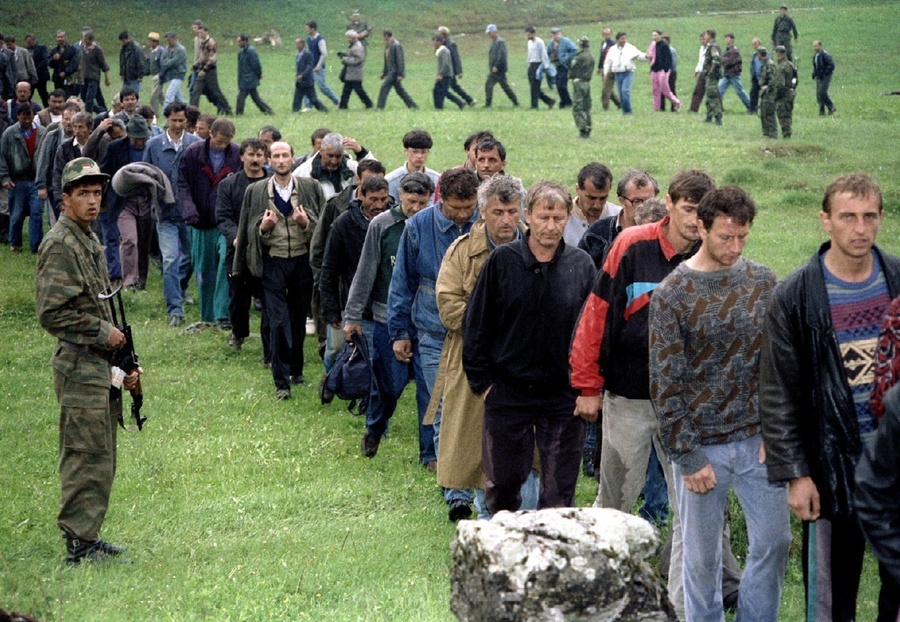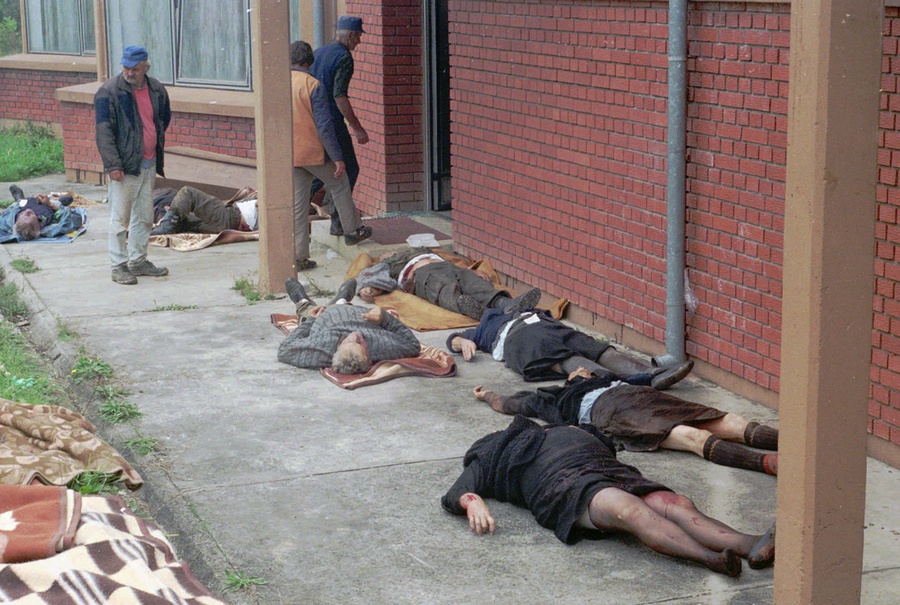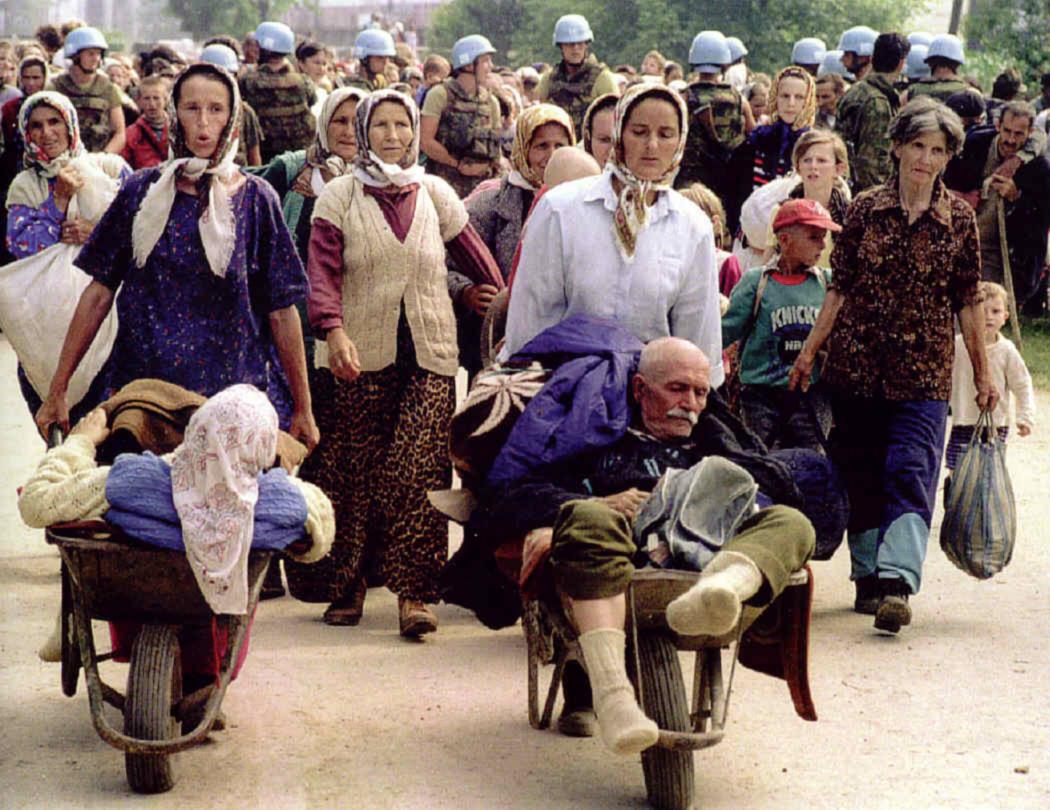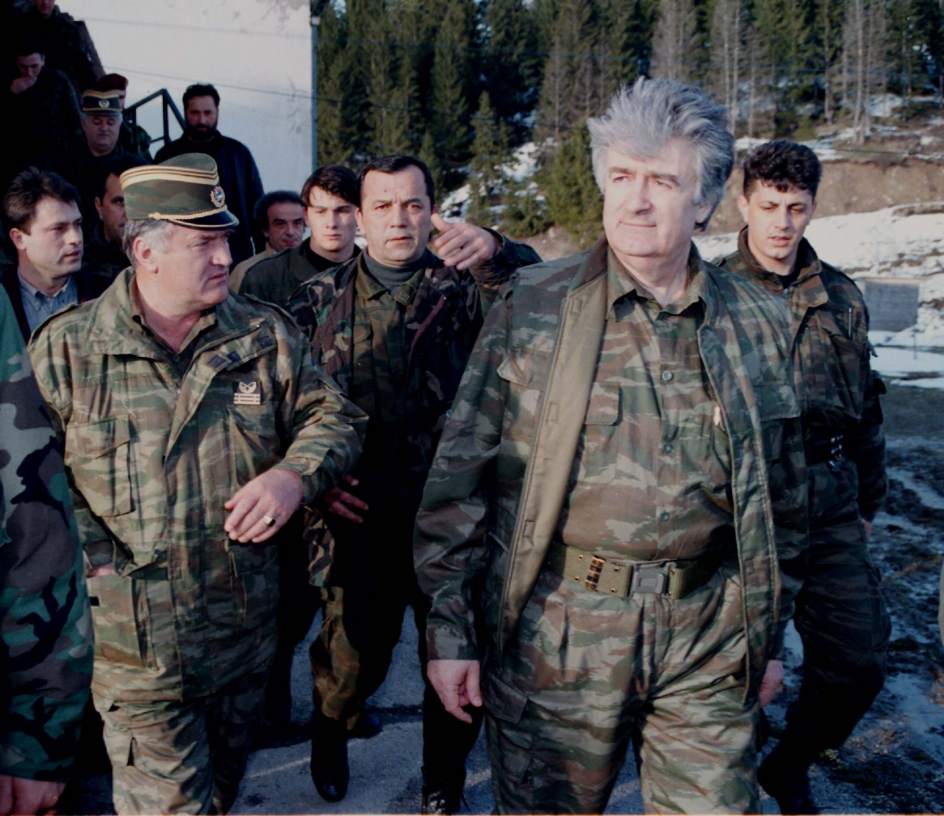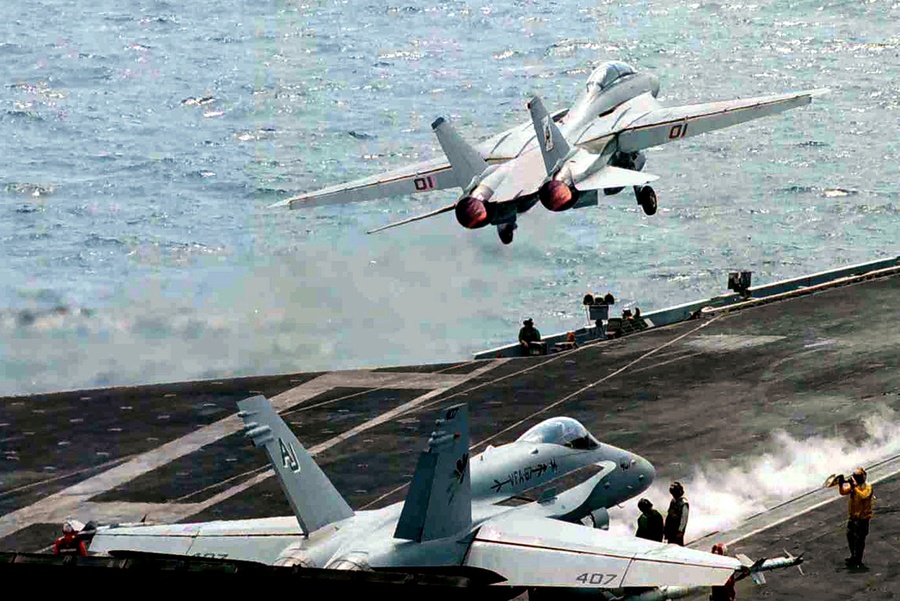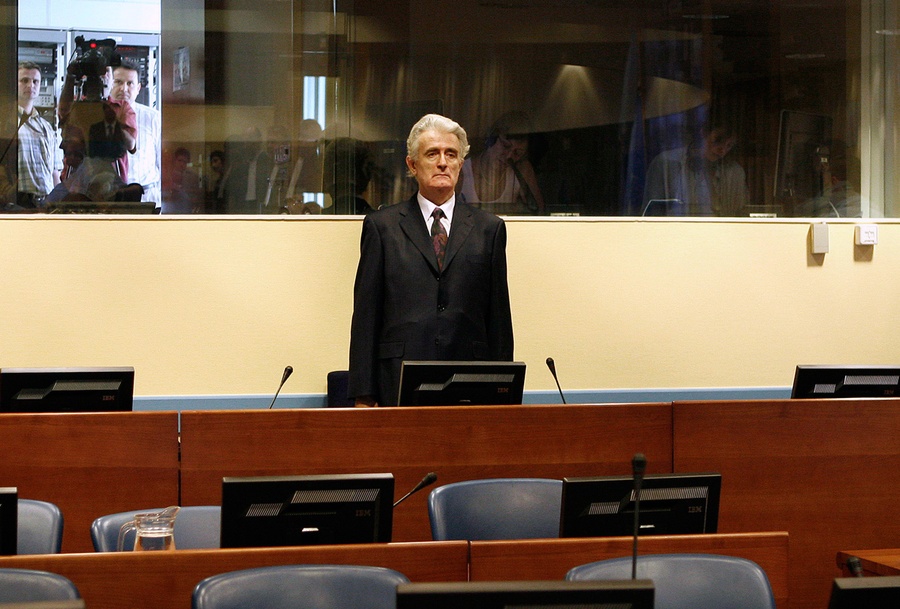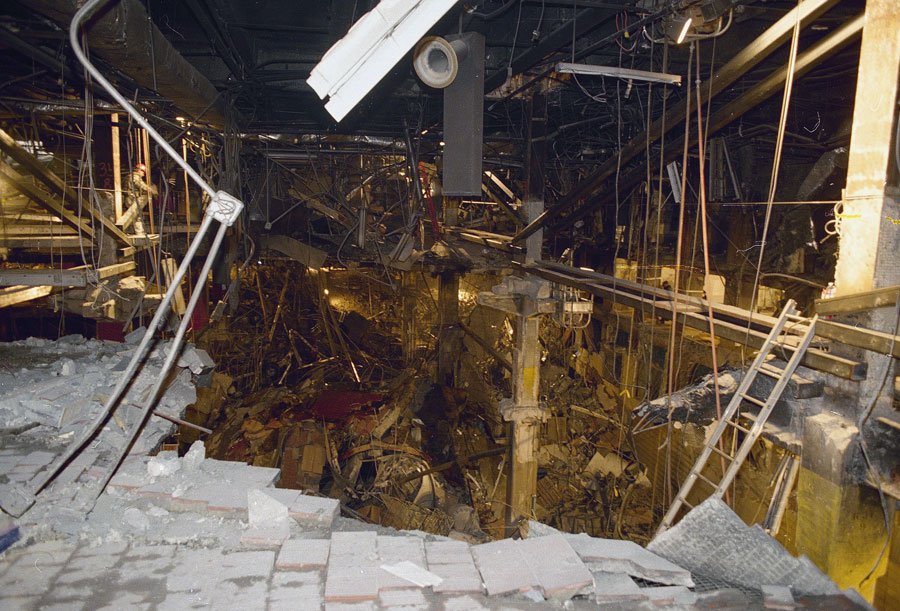20. PEACE


AMERICA TAKES THE LEAD
 "Black Hawk Down" (October 1993)
"Black Hawk Down" (October 1993)
 The Oslo Accords (1993 and 1995)
The Oslo Accords (1993 and 1995)
 Restoring Haiti's "democracy"
Restoring Haiti's "democracy"
(September 1994)
 "Ethnic cleansing" in Rwanda (1994)
"Ethnic cleansing" in Rwanda (1994)
 Mounting problems with the world of
Mounting problems with the world of
Islam
The textual material on page below is drawn directly from my work
A Moral History of Western Society © 2024, Volume Two, pages 373-380.
"BLACK HAWK DOWN" (October 1993) |
| The
U.N. had been sending food donations to help a starving Somali
population caught in the middle of an ongoing civil war ... only to
have these contributions confiscated by the various warring groups in
order to feed their own fighters. America was thus looked to in order
to bring some protection to these food deliveries. Consequently, in
October of 1993, Clinton ordered a land and helicopter assault on the
most dangerous of the warlord groupings ... only to have two of his
Black Hawk helicopters shot down and thus was forced to undertake a
rescue operation in a country that was so terrorized by the warlords
that locals were afraid to offer any assistance in the rescue
operation. Consequently, Clinton simply got his men out ... and ordered
an end to any further American assistance in Somalia. He was sorry
about the suffering of the Somali civilian population. But he was
unwilling to continue an operation that had virtually no chance of
success. And Americans were deeply appreciative of Clinton's wisdom in this matter ... similar to their reaction to Reagan's Lebanon pullout. |
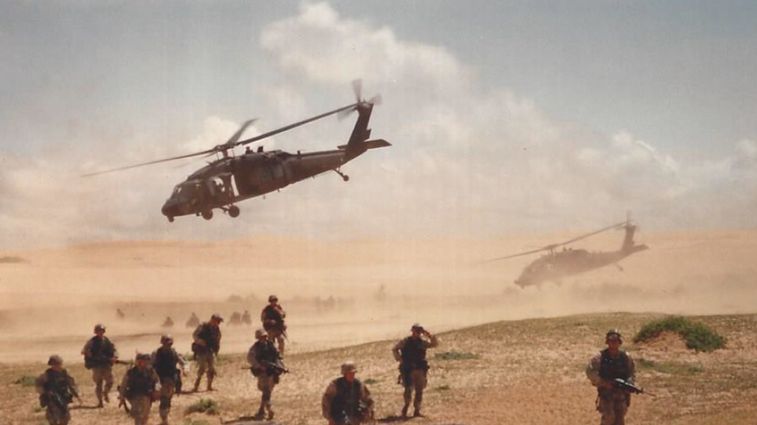
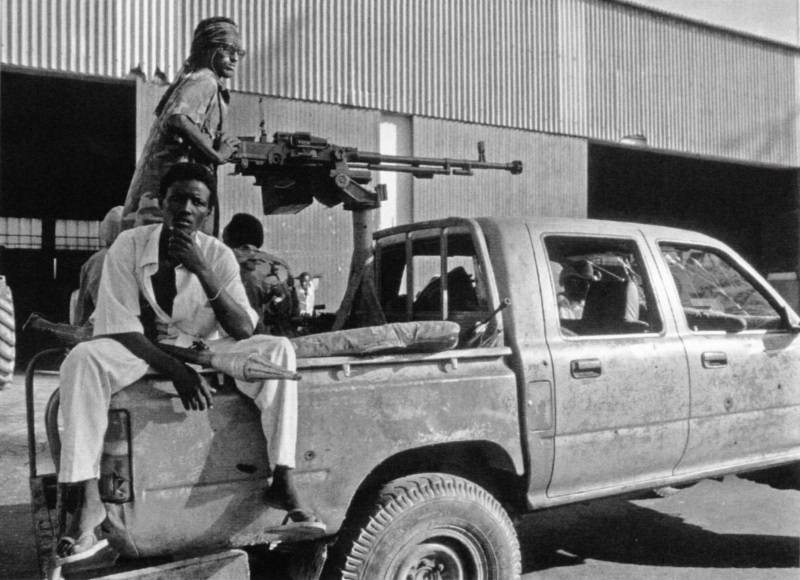
Troops of one of the warlords
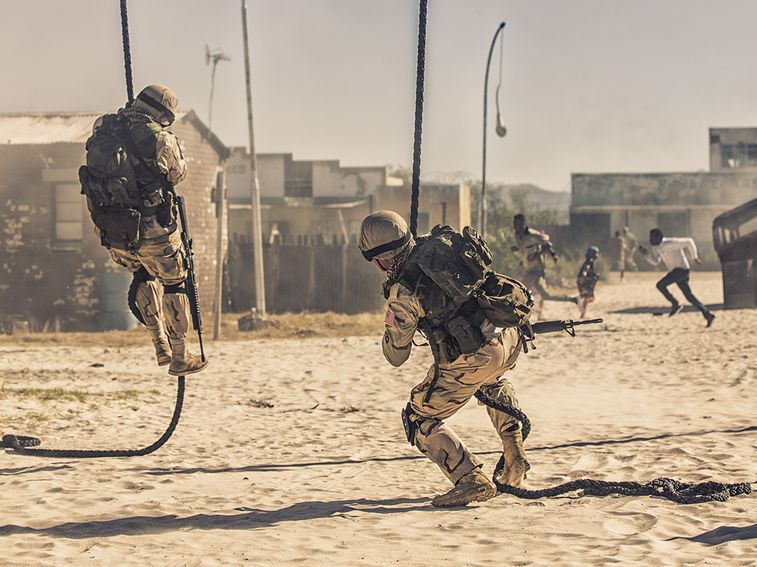
Dropping troops in Mogadishu by helicopter
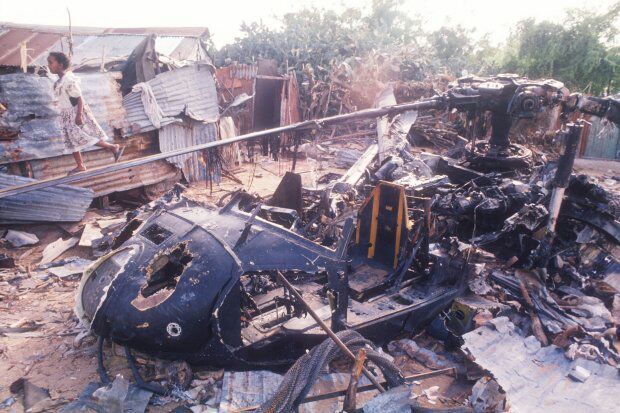
But two Black Hawk helicopters are down ... and at this point the goal switches from trying to seize Mogadishu to simply getting our downed solidiers> out of Mogadushu. A hard lesson is learned: beware of trying to save societies whose leaders do not want to be "saved."
THE OSLO ACCORDS
(1993 and 1995) |
| Secret talks between the Israeli government and the Palestinian Liberation Organization (PLO) resulted in the Palestinian recognition of the right of Israel to exist and the Israeli recognition of the PLO as the Palestinian spokesman ... with an agreement (founded heavily on Carter's earlier Camp David accord between Israel and Egypt) to continue the talks over the next five years – to finally put the earlier U.N. resolutions 242 into force. This would create a recognized Palestinian state in the West Bank region. In September of 1993, Clinton hosted in D.C. the formal signing of this "Oslo Accord" (the first of two such "Oslo Accords) – and then did what he could to support the fulfillment of this agreement. Unfortunately, the Israeli Prime Minister Yitzak Rabin, who had signed this agreement – and then a follow-up agreement (the Taba Agreement of September 1995) – was assassinated in November of 1995 by an angry young Israeli hardliner ... throwing the process back into chaos. |
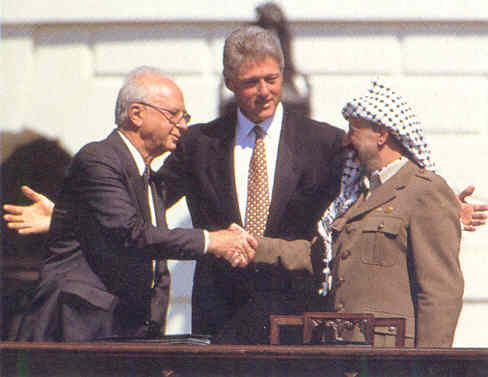
Yitzhak Rabin, Bill Clinton and Yasir Arafat formalizing the Oslo Accords in Washington, D.C. - September 3, 1993.
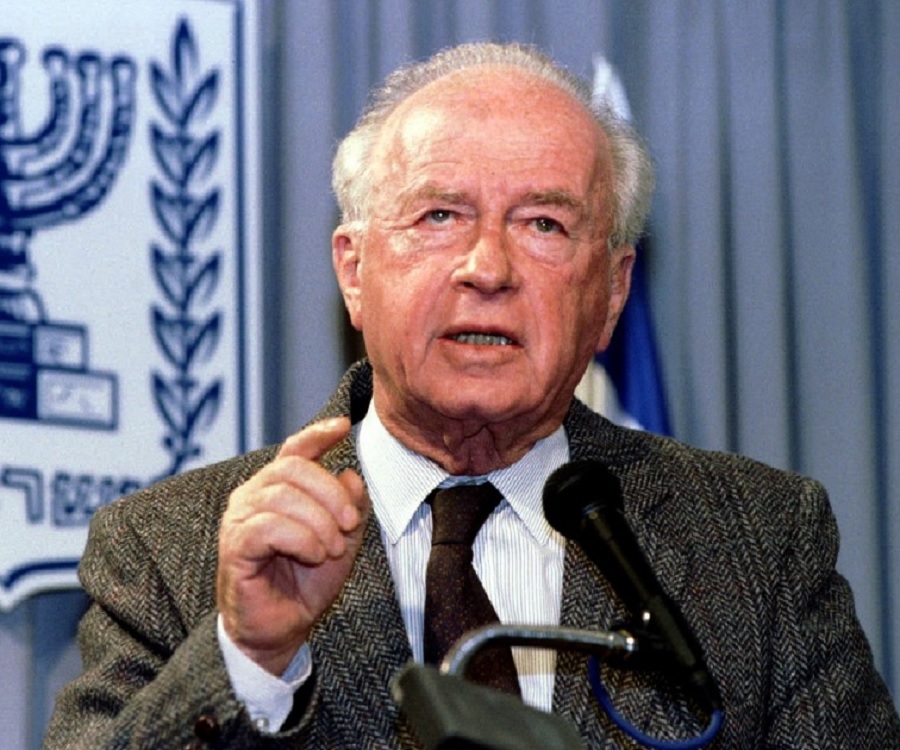
Yitzak Rabin ... and a photo of his being shot and killed (November 4, 1995) by a right wing extremist Jewish student Yigal Amir
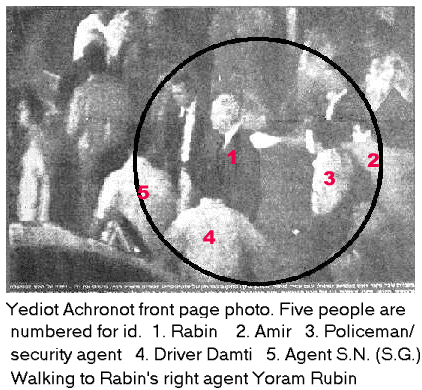
RESTORING HAITI'S "DEMOCRACY" (September 1994) |
|
In
1994, Haiti's military overthrew the country's first truly
democratically-elected president (1991), former Catholic priest Jean
Bertrand Aristide ... plunging the country into confusion and economic
catastrophe. Inevitably, masses of Haitians tried to escape the
horrible conditions that fell on Haiti – by finding anything that would
float ... hopefully bringing them to safety as refugees in America. But
vastly overloaded, most of these boats sank somewhere along the way.
The situation was deeply tragic. Once again, the U.N. asked Clinton to step in to end the chaos. But still stinging from the Somali disaster, Clinton at first hesitated to get involved. But sensing that – unlike the Somali situation – he had the support of the Haitian population, he finally decided to take on the challenge. First he sent strong American representatives – former president Clinton, Gulf war General Colin Powell, and Senator Nunn to Haiti to inform the Haitian military junta that if they did not restore Aristide to power, then Clinton would be obligated to send U.S. troops to Haiti to do the job themselves. At first the junta thought Clinton was bluffing. But in September of 1994, as U.S. ships carrying some 20,000 82nd Airborne Division troops drew closer to Haiti, the junta realized that they were in deep trouble ... and backed down, agreeing to turn the country over to Aristide the following month. And thus with these American troops in position in Haiti, the transfer was carried out peacefully. Then the American troops were soon pulled out. And Clinton indeed looked to be the leader that the world was hoping him to be.1 1Of course it was not long before Haitian politics took on a familiar look ... even under Aristide ... and by 2004 Haiti had again fallen into a state of civil war. Aristide was then "rescued" by U.S. forces that flew him out of Haiti ... and into exile in South Africa. He would eventually (in 2011) return to Haiti ... only to find all kind of legal impediments preventing him and his party from a fair representation in the country's National Assembly. 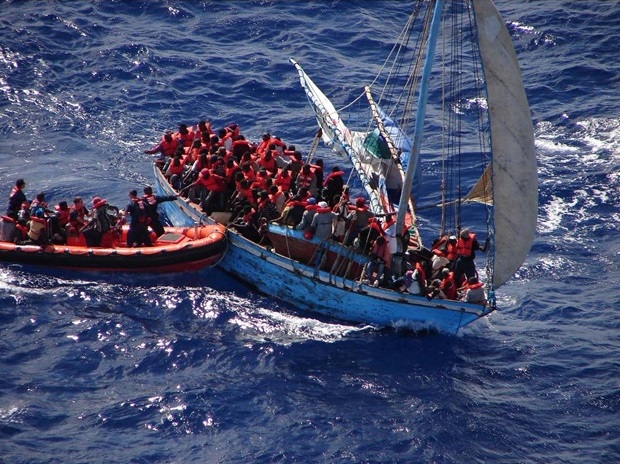 Haitian "boat people" being intercepted by US agents 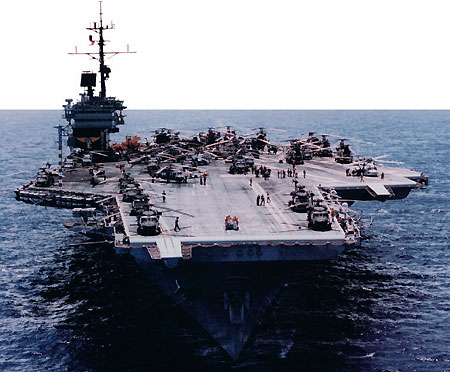 Carrier USS-America-headed-for-Haiti 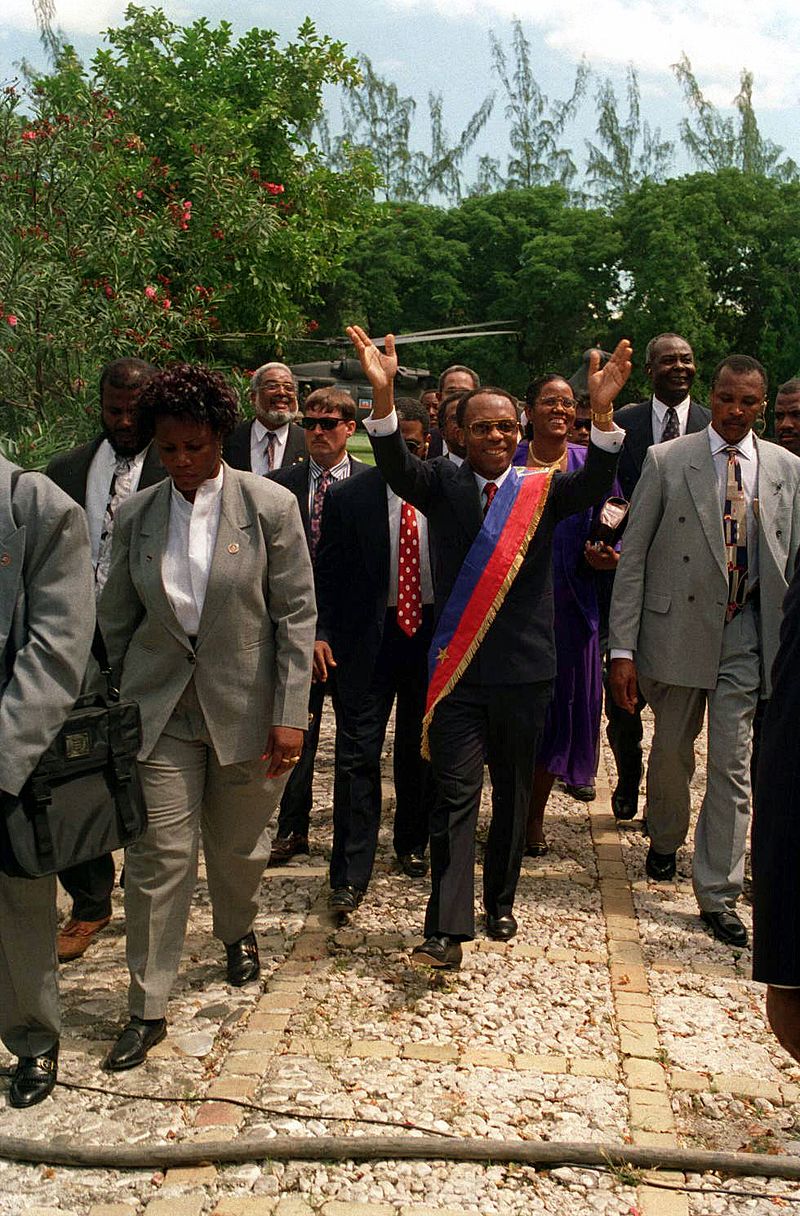
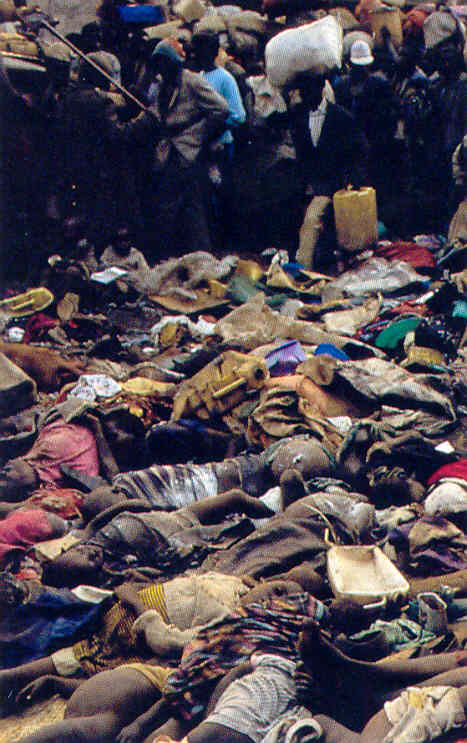 The living and the dead at
a Rwandan refugee camp in Zaire - 1994
The living and the dead at
a Rwandan refugee camp in Zaire - 1994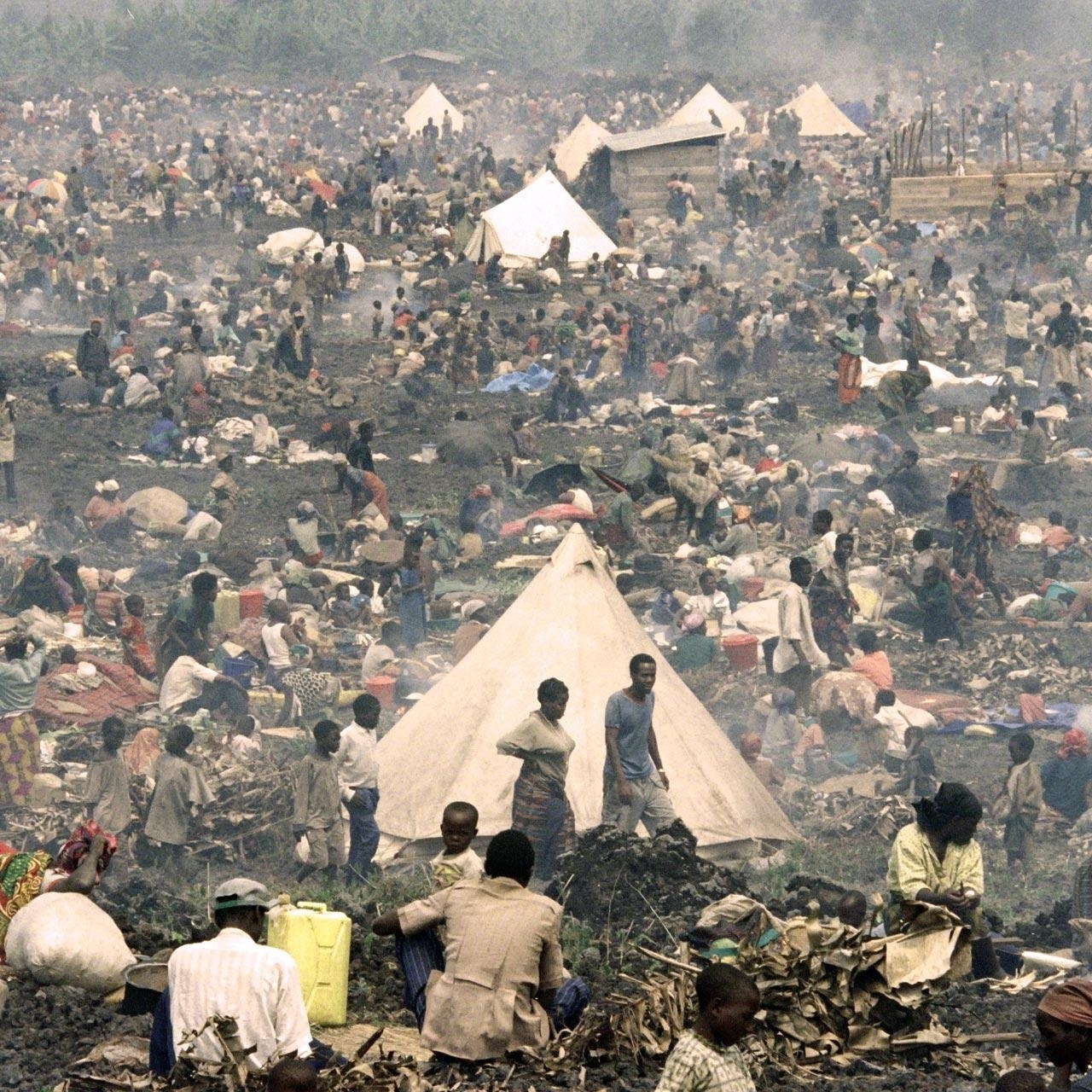 Life inside a Rwandan refugee camp - 1994 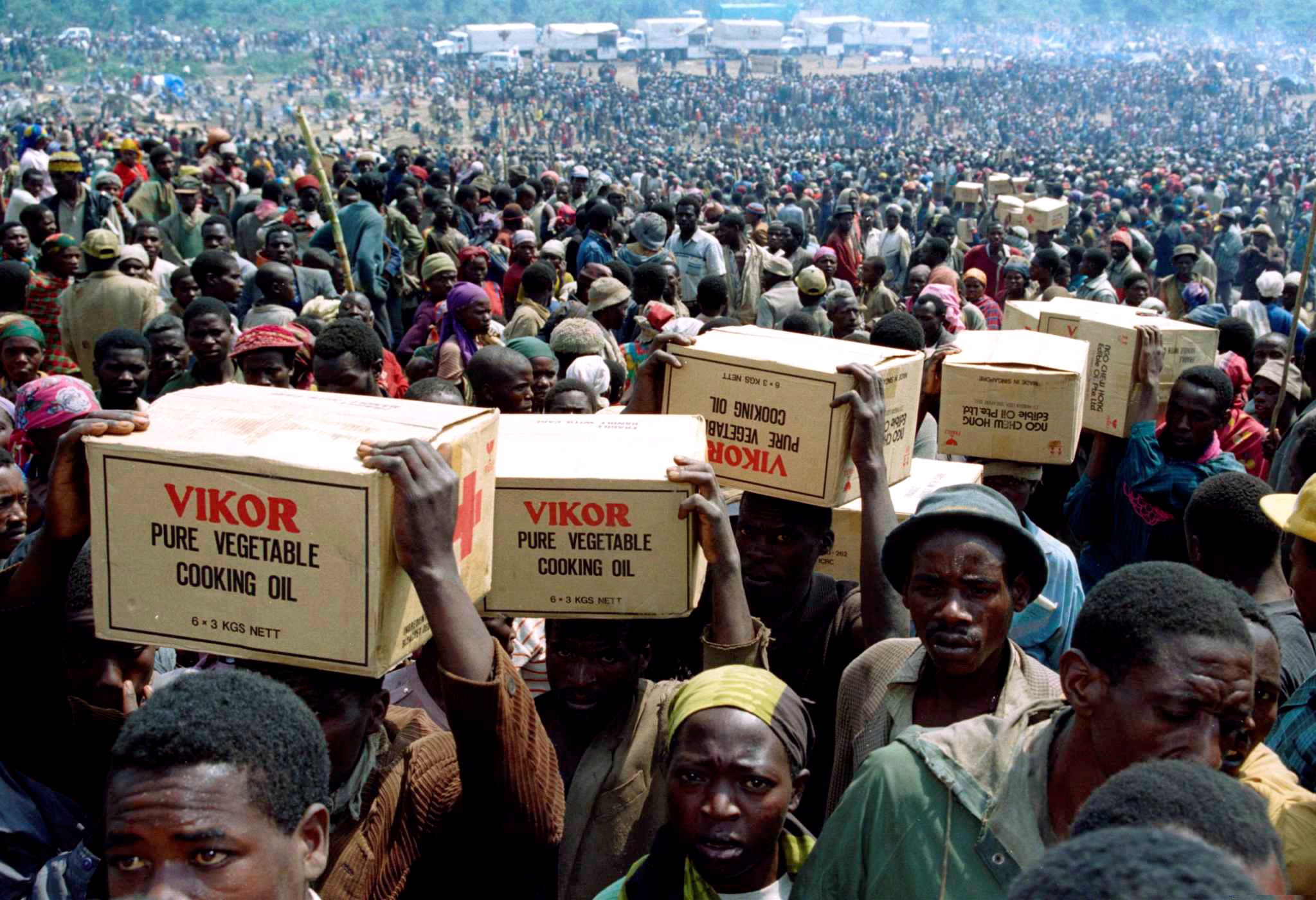 Trying to feed a desperate Rwandan population
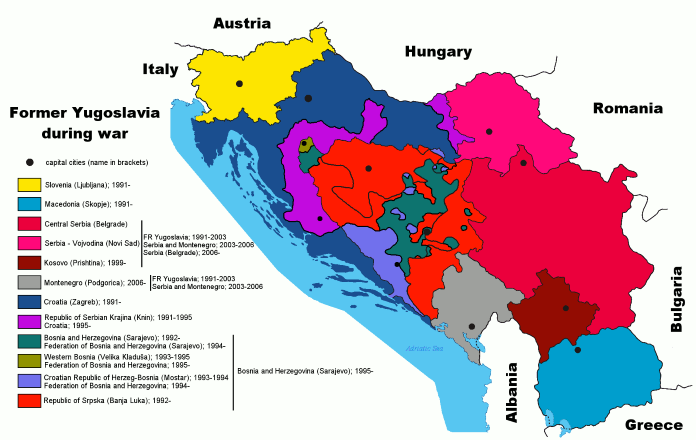
A Croatian boy mourning the loss of his father, a policeman killed by Serbs - September 1991 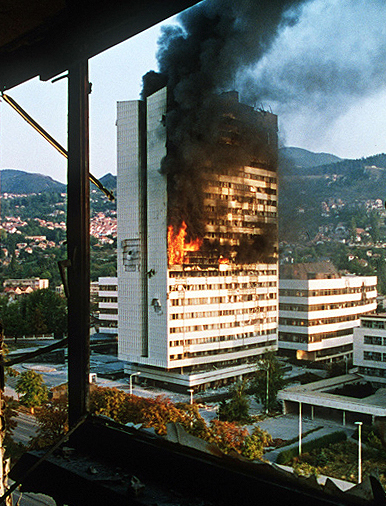
The building of the Parliament of Bosnia and Herzegovina burns after being hit by Serbian tank fire during the siege in 1992 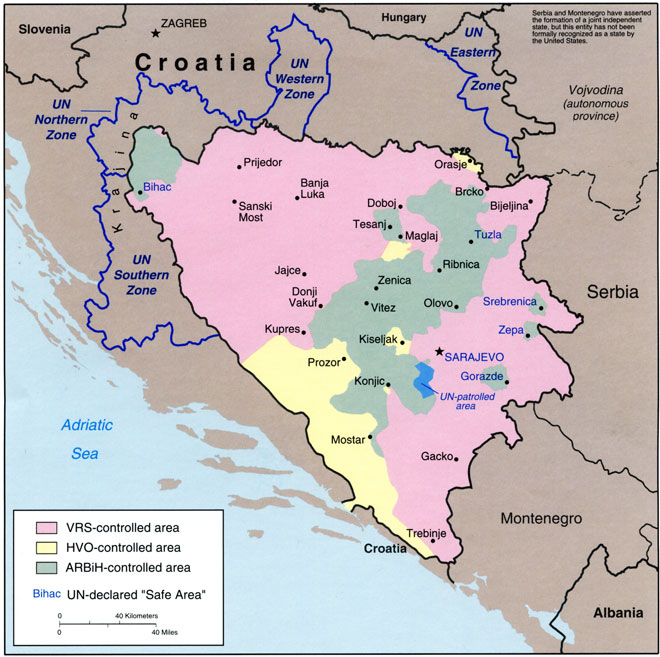
Areas of control in Bosnia
and Herzegovina, September 1994
Sarajevo itself became a slaughterhouse as hostile forces fired across streets, catching civilians in the cross-fire. 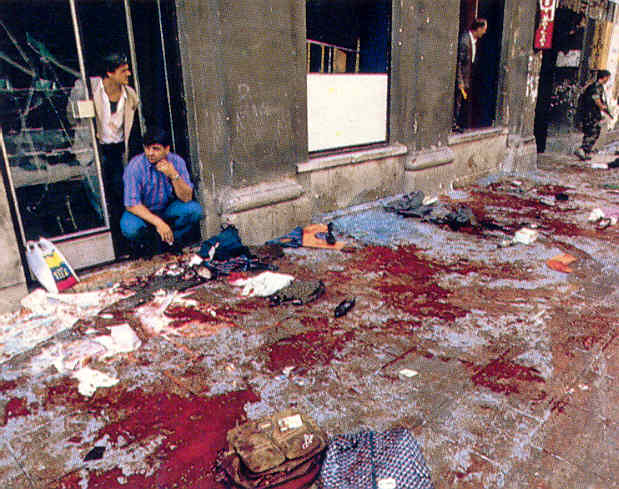
The aftermath of an attack in the Bosnian capital city, Sarajevo - 1992 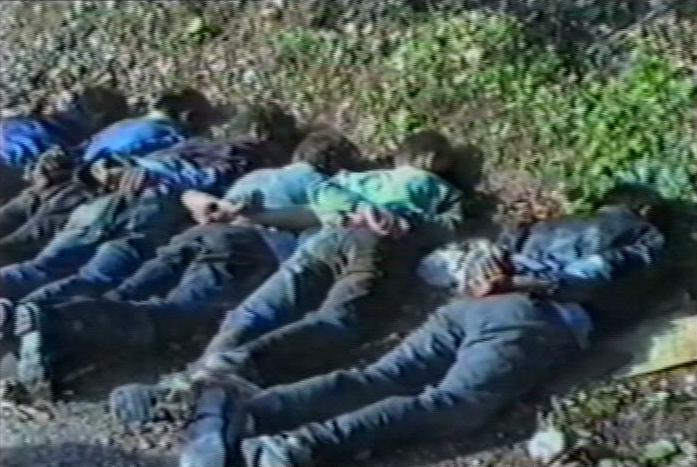
Serb troops checking Bosnian Muslim dead in Biijeljina - 1992 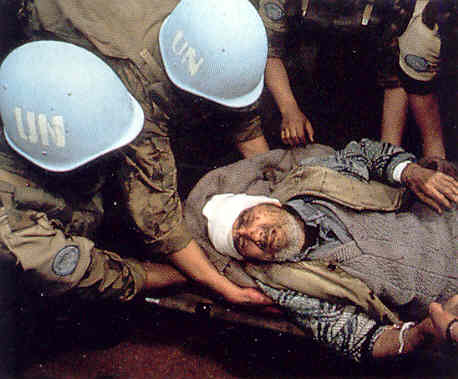
UN troops aiding wounded
civilian in Gorazde - 1994 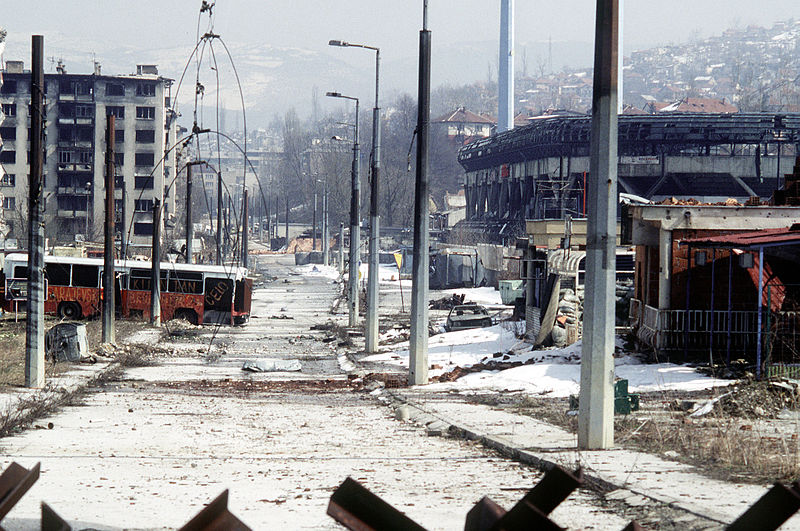
Overall view of downtown
Grbavica, a neighborhood in Sarajevo Bosnian Croat soldiers taken as prisoners by Bosnian Serbs ... although about 7,000 Croat civilians chose to flee to Serb-held territory in order to escape heavy Muslim assault. Ethnic cleansing however went both ways ... Serbian civilians killed by Croatian soldiers in a small town west of Sarajevo. 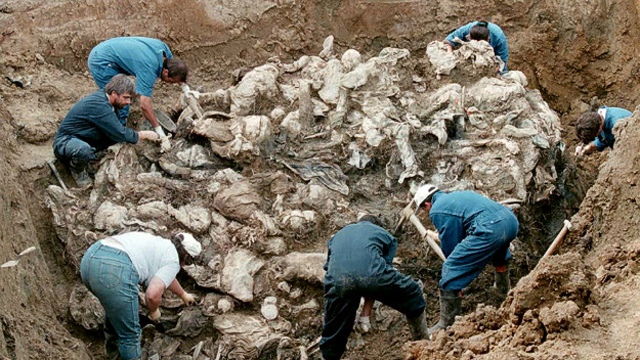
Uncovering the mass graves in Srebrenica of thousands (6,000 - 8,000?) of Bosnian Muslims killed in 1995 by Ratko Mladić's Serbs 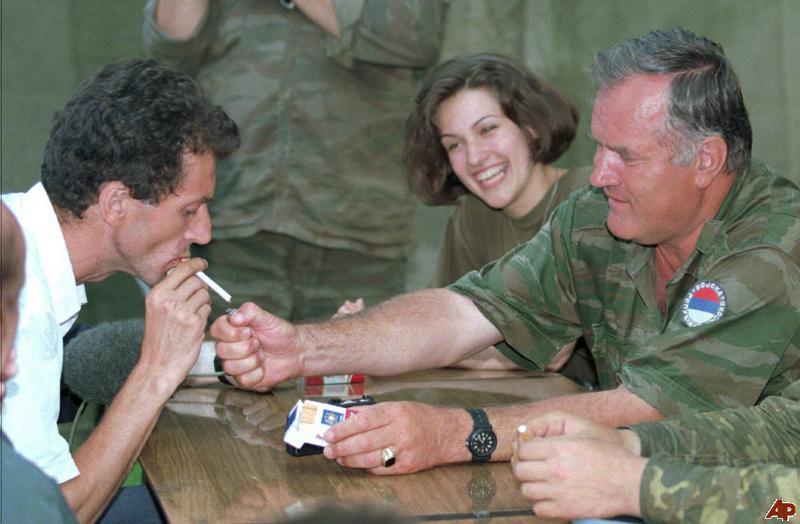
Bosnian Serb General Ratko Mladić commanding the 'ethnic cleansing' designed for the Serbian takeover of Bosnia. He would later be arrested, tried and convicted (2011) by the UN Yugoslavia Tribunal for war crimes he committed at Sarajevo and Srebrenica Serb Generals Ratko Mladić and Radovan
Karadžić ... A US F14 tomcat fighter takes off on a patrol over Bosnia from the aircraft carrier USS Theodore Roosevelt 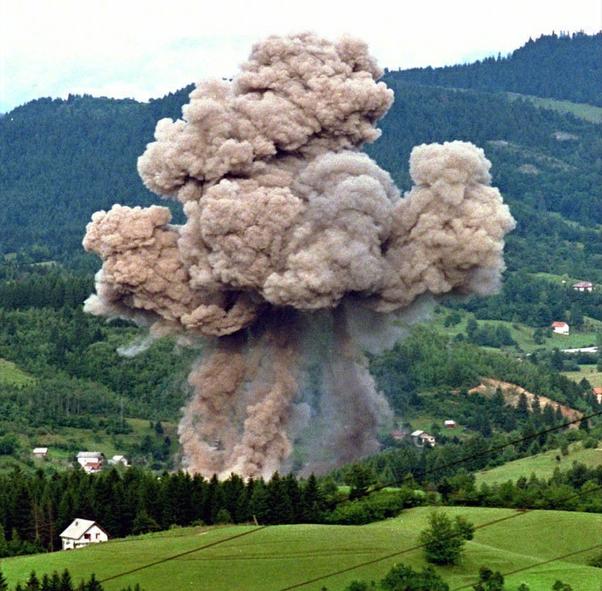
August 1995 - NATO airstrike of a Serb ammunition depot in Bosnia. 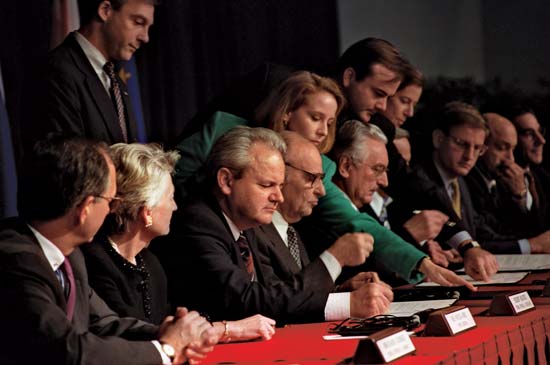
The signing in Ohio of the Dayton Accords by
the presidents of Bosnia, Croatia and Serbia 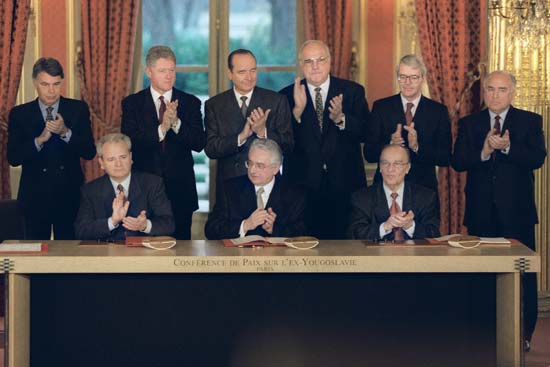
The final peace agreement is signed in Paris December 14, 1995. Seated are Slobodan Milošević (Serbia), Franjo Tudjman (Croatia), and Alija Issetbegovic (Bosnia Herzegovina). Standing behind them are Felipe Gonzalez (Spanish Prime Minister), Bill Clinton, Jacques Chirac (French President), Helmut Kohl (German Chancellor), John Major (British Prime Minister) and Viktor Chernomyrdin. (Russian Prime Minister) |
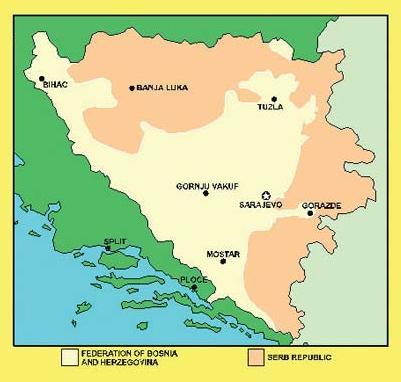
The division of Bosnia into two parts: the Bosnian-Croat Federation (Bosnia and Herzegovina) and the Bosnian Serb Republic
Bosnian Serb political leader Radovan Karadžić on trial at The Hague, Netherlands (2008)
KOSOVO (1999) |
| But
in March of 1999, upon the final withdrawal of the international
peacekeeping forces stationed in the area, violence in former
Yugoslavia once again exploded ... this time in the southern region of
Kosovo. Here part of the population was Albanian in language and Muslim
in religion ... quite different from the Slavic language and Orthodox
faith of the Serbian communities scattered here and there around the
region. Once again the violence erupted when Serbian President
Milošević began an effort to remove the non-Serbian people from what
the Serbs considered to be part of their national territory ... except
that the Albanian Kosovars (92 percent of the population) vastly
outnumbered the Serbs (only 4 percent) in the region. But Milošević was
determined to attempt this "ethnic cleansing" nonetheless. And thus he soon had over a million Kosovars in flight from their homes and into neighboring countries as refugees. As for the rest of the Kosovars, his troops were determined simply to slaughter. And of course Kosovar militants were no less eager to do the same thing to the Serbs living in Kosovo. But this time it was Clinton who took the lead in the matter, by calling on NATO to intervene ... beginning (late March) attacks once again from the air on Serbian troops and military sites in order to get the Serbs to back off from their attacks on the Kosovar population The hope was that Milošević would quickly realize that he was outmatched. But instead, Milošević simply dug in deeper. Then the Serbian capital Belgrade was extensively bombed (very unfortunately doing damage to the Chinese Embassy and killing three individuals in the process… oops!). Once again, Milošević finally (mid-June) had to admit defeat ... and agree to back his troops out of the Kosovo region – and offer no opposition to the stationing of 50,000 NATO troops there (including 7,000 Americans) as peacekeepers. But this time, Milošević himself had to pay the penalty for his actions. He was arrested as a war criminal and put in a Dutch prison ... where subsequently he died during his long trial. And – to show Kosovar appreciation – a huge statue of Clinton now (since 2009) stands just off the Bill Clinton Boulevard in Kosovo's capital city, Pristina! |
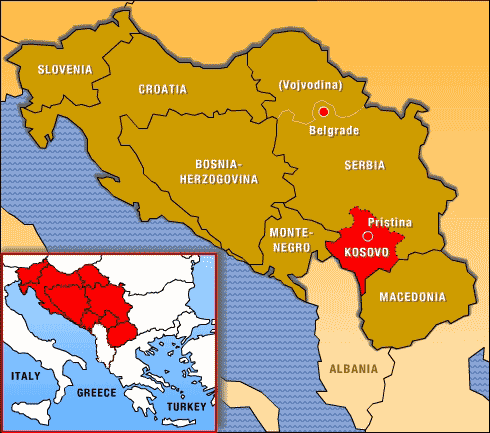
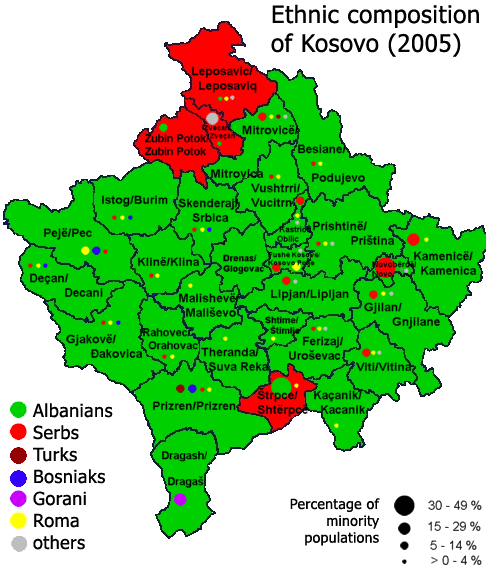
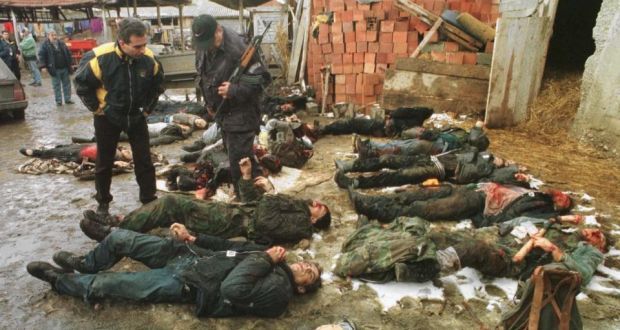
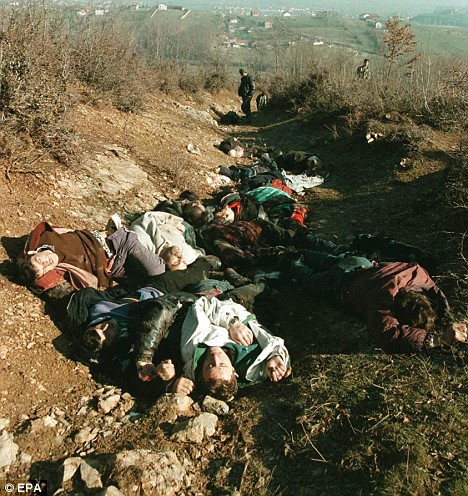
Genocide in Kosovo - Albanian dead (1999)
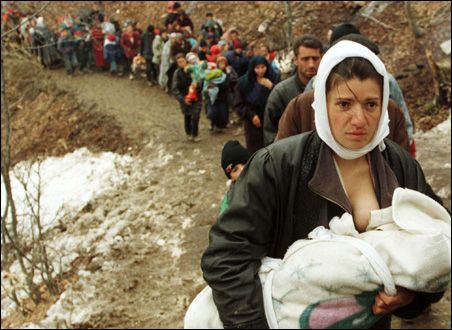
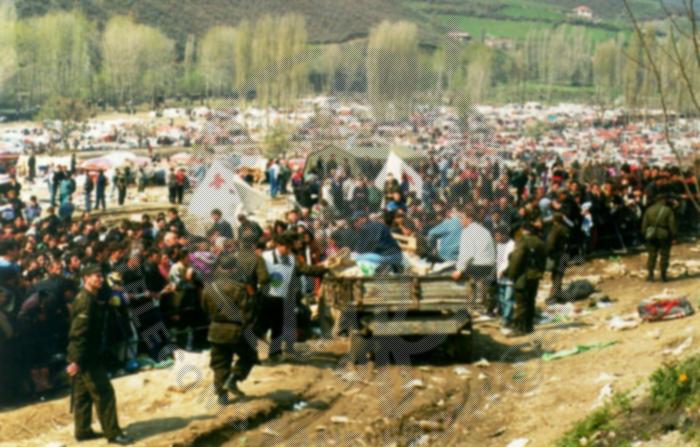
Some of the (800 thousand to 1
million?)
Kosovar refugees ... including my now son-in-law (and pastor) Rimi, who was a teenager at the time
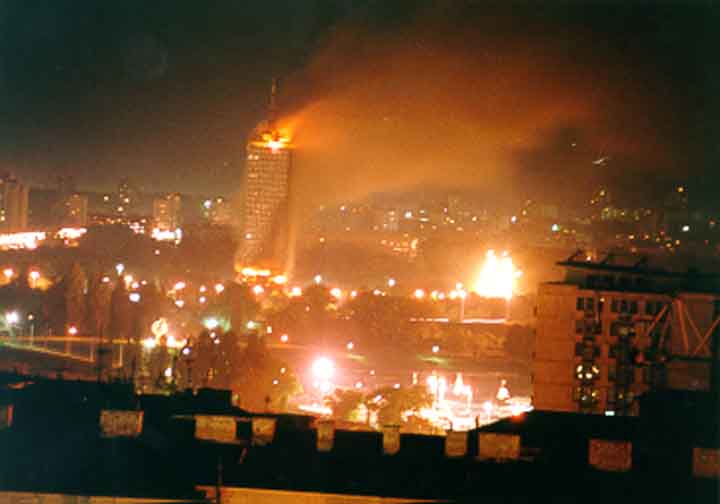
The 1999 American-led NATO bombing of Serbia's
capital
Belgrade
... forcing the Serbs to back away from their slaughter of the Albanian Kosovars

A statue of Bill Clinton in downtown Pristina, Kosovo's capital city! He is considered to be something of a "savior" by the Kosovars
MOUNTING PROBLEMS WITH THE WORLD OF ISLAM |
|
The first Muslim bombing of the World Trade Center
(February 26,1993) But America had its own version of such international bloodying when it itself became the object of attack at the World Trade Center in New York City. An explosives-filled van parked in the parking garage of the North Tower of the World Trade Center exploded ... destroying six stories of this towering New York structure. Six people were killed and over a thousand others injured ... though the situation would have been far worse had the van been parked closer to one of the supporting walls of the tower. For clearly the intention of the bombers was to collapse the entire building in such a way that it would then also fall against the other twin tower ... bringing both of them down – and the death of tens of thousands of individuals working there. Enough physical evidence was found that enabled investigators to discover that behind this action was a group of local Muslim fanatics, trained and supported by a Pakistani-based group that went by the name of al-Qaeda (or al-Qa'ida – meaning "foundation") under the direction of Khalid Sheikh Mohammed ... but the action itself being actually conducted by his nephew Ramzi Yousef – and fellow supporters based in a couple of local mosques, one in Jersey City and one in Brooklyn. The individuals involved in the action would soon be tracked down and arrested ... except one who escaped to Iraq – but was arrested and imprisoned there. The FBI tried to connect the al-Qaeda organization with Saddam Hussein. But ultimately, they could come up with no evidence linking the two. But it certainly put al-Qaeda on the FBI's watch list. The Afghan Taliban
Afghanistan was always just a huge region of different ethnic groups ... once held together through a broad alliance of local tribal and religious leaders with the Afghan Shah. When he was overthrown in 1973 by his cousin who claimed to be setting up an Afghan Republic in doing so ... the alliance broke down and Afghanistan found itself caught in contests, very bloody in many cases, for control of this or that part of the country. The Soviets had hoped to use this opportunity to put their own "protection" over some kind of pro-Soviet government operating out of Afghanistan's capital Kabul since 1978 ... even sending Soviet troops into Afghanistan to shore up the pro-Soviet puppet government in 1979. But this government had little power beyond the capital city itself ... and was easily subject to political undermining by Afghan tribal leaders – supported quietly by American financial and weapons assistance. Finally, with the Soviet pullout from Afghanistan in 1989 – and the collapse of the Soviet system itself that soon followed – the Afghanistan system collapsed ... opening the way for the creation in 1992 of the Islamic State of Afghanistan. But this only intensified the inter-tribal and inter-religious fighting gripping the country. Tens of thousands (probably even hundreds of thousands) of Afghans died as a result of all this political turmoil. The strongest group in the country – making up about 40 percent of the population are the Pashtun ... occupying the southern and southeastern parts of the country – as well as a good part of northern Pakistan. They are the ones usually governing the country. The Pashtun are an ultra-conservative Sunni Muslim people – that have long looked down on the Tajiks (30 percent of the population) and Uzbeks (10 percent of the population) in the northern parts of the country. And they despise deeply the Hazaras (not quite 10 percent) living in the mountainous center of the country. In the midst of all this conflict, a small group of mostly Pashtun Sunni hardliners, who called themselves the "Taliban" (from the Arabic word for "student"), formed in the Pashtun region of Northern Pakistan around the teachings of an Islamic fundamentalist teacher, Muhammad Omar. For various reasons, this Taliban group also found itself strongly supported by elements in the Pakistani intelligence service. In 1994 members of the Taliban crossed into Afghanistan and quickly set themselves up in Kandahar ...from which they brutally organized much of the rest of the Pashtun community into a fighting force. And in 1996 – with strong support from both Pakistan and Saudi Arabia – they were able to march their troops on Kabul and force the government there to flee to the north. But many Afghans, in order to escape the brutality of the Taliban, followed the former government north ... where finally there was established a "Northern Alliance" under the former Afghan Defense Minister Ahmed Shah Massoud. By 2001, over a million Afghanis had fled to the north ... where Massoud was able to establish something of a stable and fairly open society there. In all this, America took no action. But the country wondered why its supposed allies Saudi Arabia and especially supposedly-modernizing Pakistan would be supportive of the Taliban regime. In the very near future, this would become a very high priority matter to America ... especially as al-Qaeda was allowed to set up military training camps in Taliban-controlled Afghanistan. Al-Qaeda bombs the American embassies in Tanzania and Kenya (August 7, 1998)
Then, without any prior notice or any explanation, suicide bombers ripped apart the American embassies in Dar es Salaam (Tanzania) and Nairobi (Kenya), killing 212 people in the process and wounding hundreds more. The American CIA was quick to detect this as the hand of al-Qaeda ... or more particularly its Egyptian branch, Egyptian Islamic Jihad. A furious Clinton immediately responded with guided missile strikes on al-Qaeda's Afghan training camps (the al-Qaeda camps in Pakistan, however, were definitely off limits to a similar American response!). But also he targeted a supposed chemical weapons factory in Sudan – although it turned out that he was wrong about what it was that this factory was actually manufacturing (pharmaceuticals mostly)! Saddam Hussein's Iraq
Meanwhile, tensions were growing over Saddam Hussein's activities in Iraq. Actually, problems developing with Saddam Hussein's Iraq during those days originally had little to do with the issue of Islam – though that would soon develop as a matter of critical importance to Iraq ... when American action in Iraq would soon throw the country into a vicious civil war among the country's Sunnis, Shi'ites and Kurds. Since the forced removal of Iraqi troops from neighboring Kuwait in 1991, a very close watch had been put on Saddam ... out of a concern about how he would try to restore his "strongman" reputation in the region. Great was the concern that he would violate the post-Gulf-War agreements forbidding the use – or even development – of chemical or biological weapons. But added to that was a growing concern that he might even try to develop nuclear weaponry.* In short, a growing concern was that Saddam might be secretly developing "weapons of mass destruction" (WMDs). Thus it was that in October of 1998, Clinton extended financial aid to Saddam's political opponents in Iraq ... and then in December – along with the British – conducted airstrikes against Iraq. But though justified as addressing the issue of Iraqi WMDs, actually it was military sites – not industrial development sites – that were struck. Certainly another motive was simply that of crippling or even bringing Saddam's regime down altogether. Actually, the airstrike did not go over well with much of the international community ... especially the Arab world – but also Russia, China and even France. Even some Americans claimed that this was only a Clinton distraction from the scandal that was sweeping America at the time, one concerning Clinton's just-discovered affair with a young White House intern. But it is more likely that what motivated this action was a growing concern among the Washington leadership (and the British as well) that the Muslim world was becoming increasingly threatening to the Western world ... and that Saddam was possibly supporting this development. Thus a show of force seemed to be necessary to back down any such ambitions potentially arising in that threatening world. Time would soon tell who had this right. |
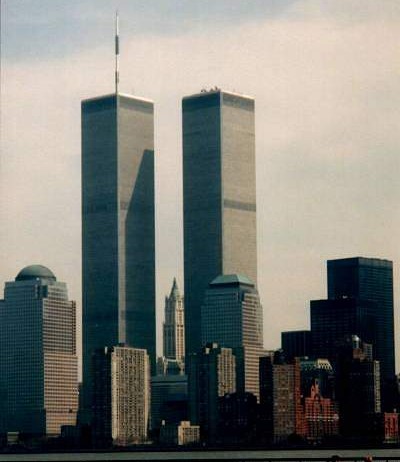
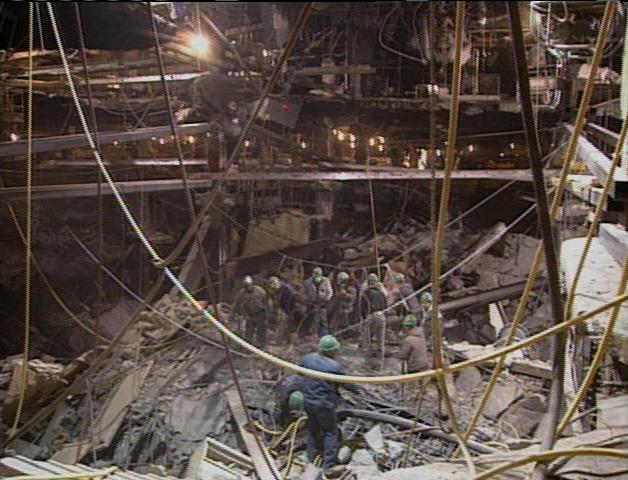
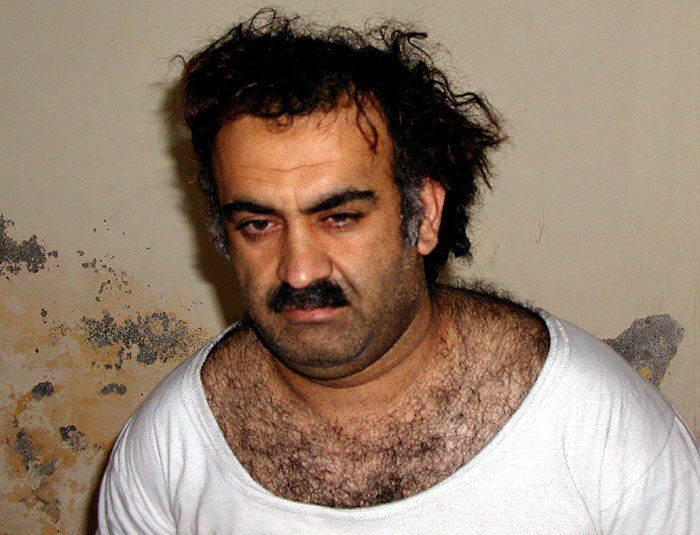
Khalid Shaikh Mohammed, upon
capture 8211; March 2003. He also masterminded the
second attack on the Twin Towers on 9-11 2001
... as well as other attacks
on Western society
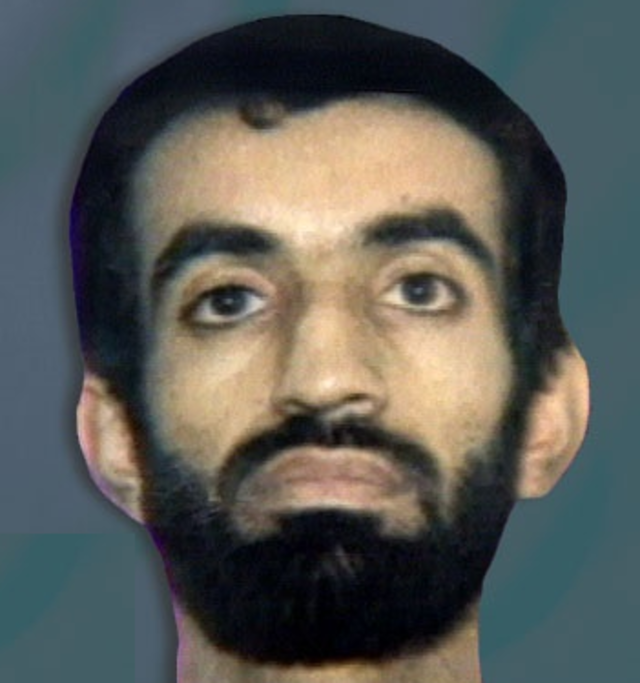
Ramzi Yousef – nephew of
Khalid Shaikh Mohammed -
and operational leader of the 1993 WTC
attack
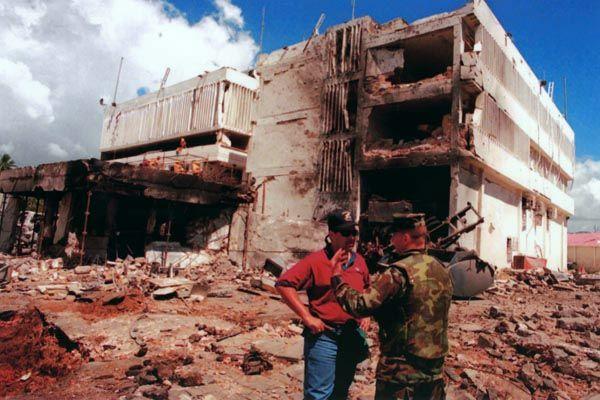
The U.S. Embassy in
Dar es Salaam, Tanzania,in the aftermath of the
August 7, 1998, al-Qaida suicide bombing
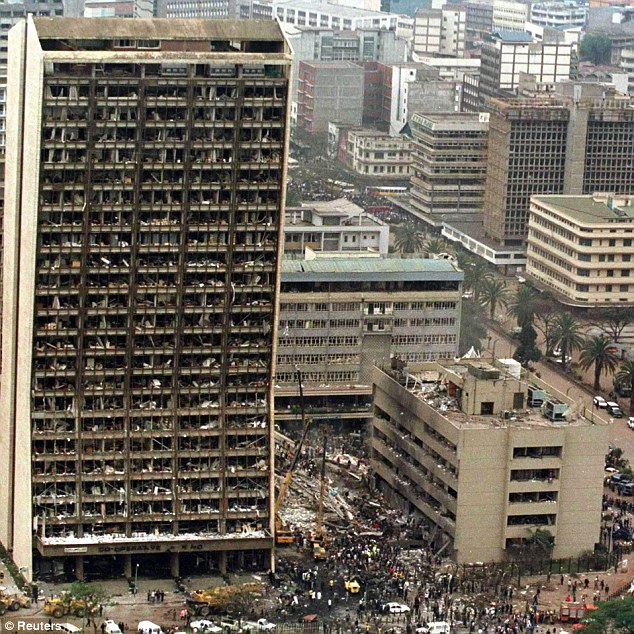
The U.S. Embassy bombing
in Nairobi, Kenya - August 7, 1998
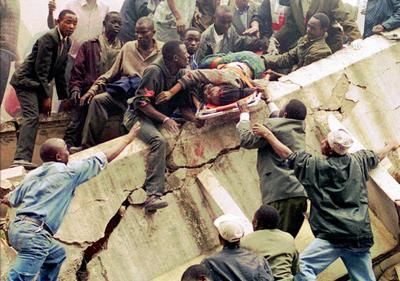
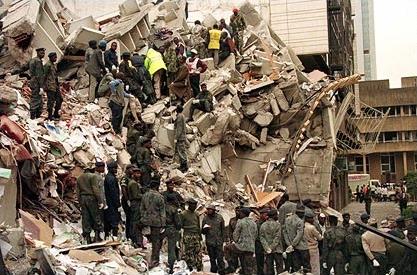
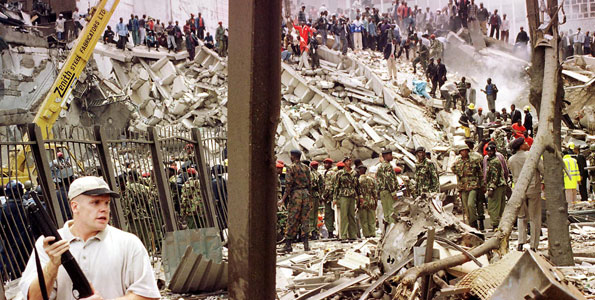
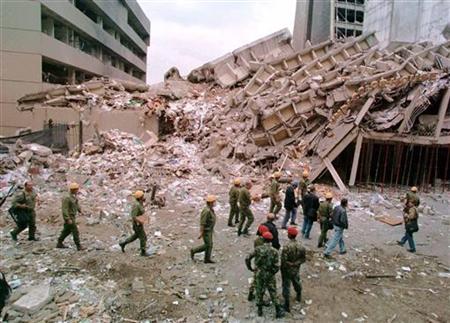
American retaliatory attacks
on al Qaida training camps in Afghanistan and supposed supply depot in
the Sudan - August 20, 1998
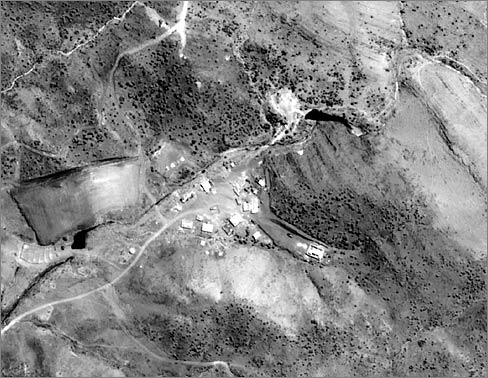
"1998 satellite image released
by the U.S. Government of an Al-Qaeda training camp at Zhawar Kili, Afghanistan
that was later bombed during Operation Infinite Reach"
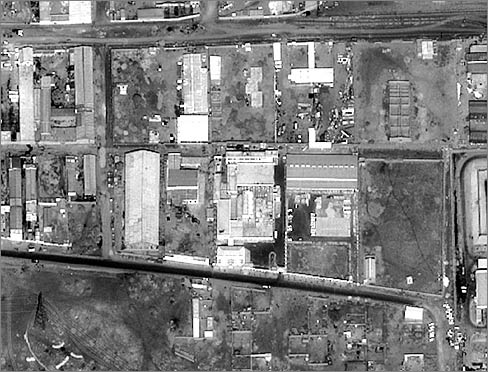
"1998 US Government
photograph
shows a suspected bioweapons production facility in Shifa, Sudan that the
U.S. destroyed in the wake of terrorist bombings of the American embassies
in Kenya and Tanzania that year."


The U.S. Embassy in Dar es Salaam, Tanzania,in the aftermath of the August 7, 1998, al-Qaida suicide bombing

The U.S. Embassy bombing in Nairobi, Kenya - August 7, 1998




American retaliatory attacks on al Qaida training camps in Afghanistan and supposed supply depot in the Sudan - August 20, 1998

"1998 satellite image released
by the U.S. Government of an Al-Qaeda training camp at Zhawar Kili, Afghanistan
that was later bombed during Operation Infinite Reach"

"1998 US Government photograph shows a suspected bioweapons production facility in Shifa, Sudan that the U.S. destroyed in the wake of terrorist bombings of the American embassies in Kenya and Tanzania that year."




